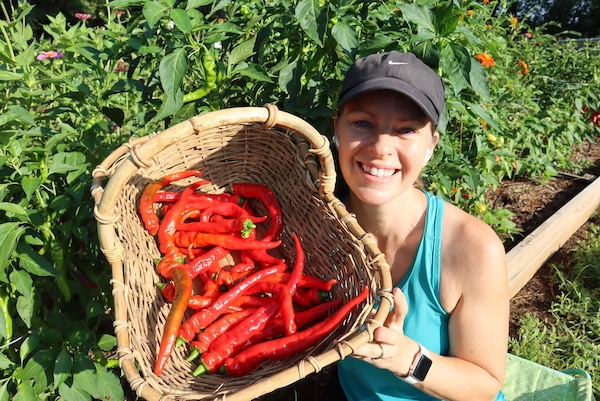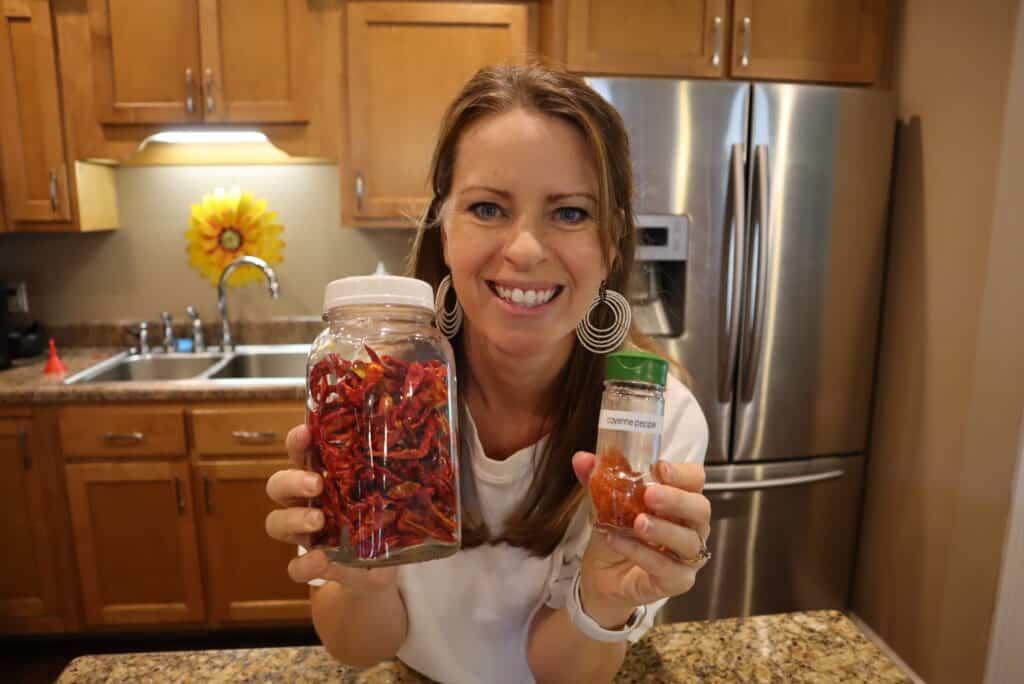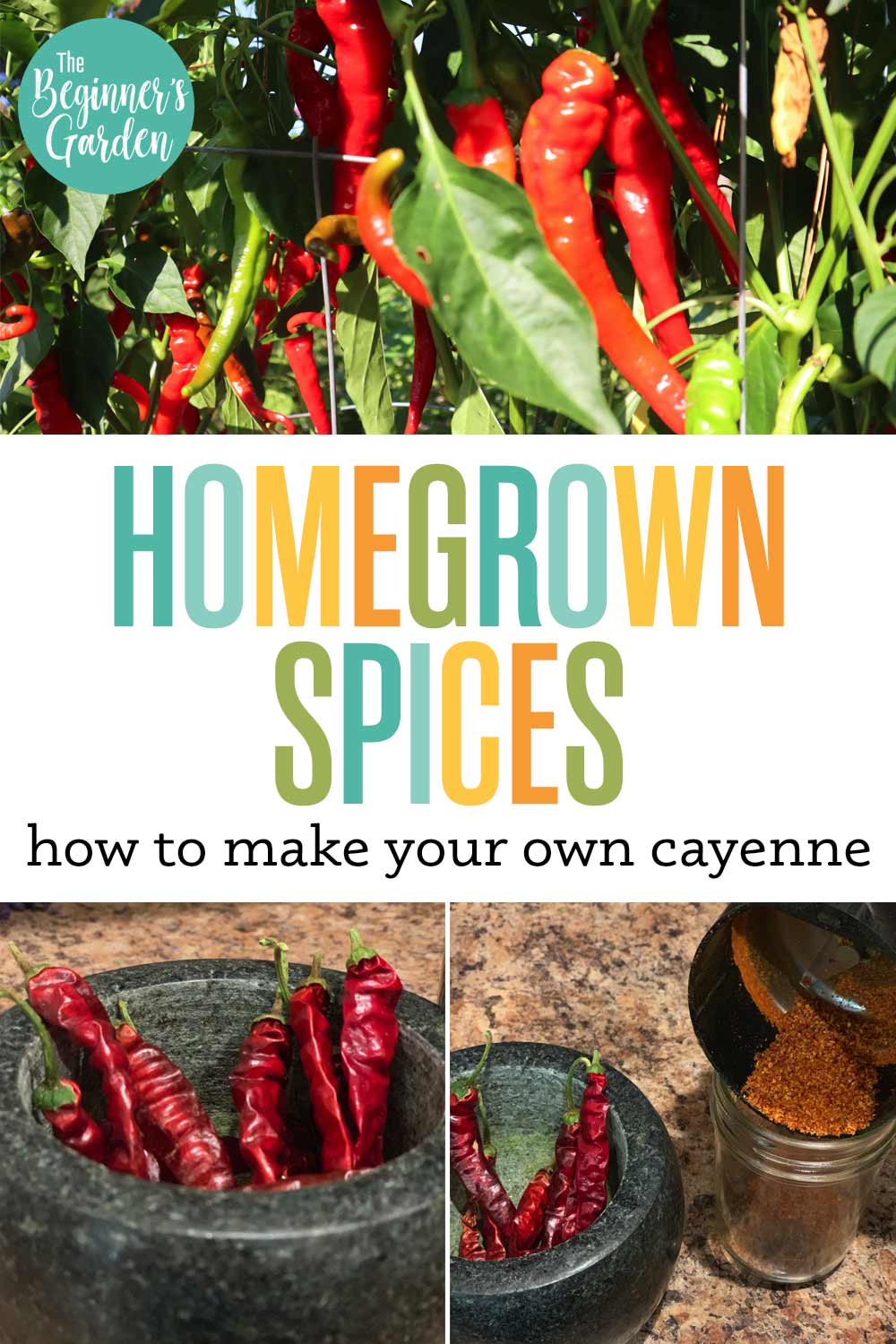Homegrown Spices: How To Grow Your Own Cayenne Pepper
If you are ready to spice things up, it’s time to learn how to grow your own cayenne pepper for red pepper flakes or ground cayenne powder.
Yes, not only can you grow your own vegetables, fruits, and herbs in your home garden, you can also learn how to grow your own spices like cayenne pepper, paprika, chili powder, and more that can last your family all year long.
Growing and making your own spices is a wonderful way for your garden to save you money — and you’ll enjoy fresh spices, too! Dried and ground spices are much more flavorful than those that have been sitting on a grocery store shelf for who knows how long.
Let’s start by learning how to grow your own cayenne pepper.
Tips to Grow and Harvest Cayenne Peppers
When it comes to growing your own spices, there are a few tips you’ll need to be aware of before you begin. Beginning with growing your own cayenne pepper, these tips will show you how to turn your freshly grown peppers into cayenne pepper spice that you can save and use all year long.
If you would rather watch than read these tips, you can watch the video below:
Choose the Right Variety
Selecting cayenne peppers to grow at the beginning of the season is straightforward. While the amount of pepper varieties available in a seed catalog can make your head spin, all you have to do is look for “hot” peppers and find varieties that either have the word “cayenne” or “red chili” in their name or in the seed description.
Consider Larger Cayenne Types
As you consider which type of cayenne pepper variety to use, keep in mind that larger the pepper size, the easier it is to work with. This is a personal preference, but having grown both small, thin cayenne peppers and a larger variety, I prefer the larger. Not only is it faster to pick one 9″ pepper compared to a dozen small ones, but it’s also easier to prepare for dehydrating.
My favorite is Arapaho because these peppers are 8-9in when fully ripe. You can order them from Territorial Seed Company (affiliate link).

The exception I’d make to this is if you have a short growing season. It will take a bit longer for the larger cayennes to reach full maturity. If your growing season is short, choose smaller cayennes so they will mature before fall. Also, read the seed catalog description carefully because they will often tell you which varieties mature earlier than others.
Plant at the Right Time
While you can purchase cayenne peppers as transplants at your local garden center, if you choose to start cayennes from seed, start the seeds indoors early — about eight to ten weeks before your average last frost date. Then, wait until nighttime temperatures rise into the 60s consistently (50s are okay occasionally) to plant into the garden.
Plant in Full Sun
Hot peppers require more “heat” than sweet peppers. While they are often easier to grow than sweet bell peppers, they still need full sun to get to maturity.
Let Peppers Mature and Harvest Carefully
Make sure you let your peppers grow fully and mature before you pick them. Mature peppers are bright red without any green or dark spots on them. When you cut them off the plant make sure to use clippers so you don’t injure or tear the plant as peppers don’t dislodge easily.

Wear Gloves
You’ll want to make sure you are wearing gloves to protect your hands when you are working with cayenne peppers. These peppers are hot and can burn your skin after prolonged use. This is especially the case when cutting them open as you prepare to dehydrate.
Don’t Grind All Your Peppers At Once
While you can dehydrate all of your cayennes at the same time, don’t grind them all at the same time. Instead, consider only grinding a little bit at a time. I like to use a 2-ounce spice jar (like these jars *affiliate link).
The reason for this is that with homegrown spices, they lack the anti-caking agents of spices you’d otherwise purchase. By only grinding what you need, as you need it, your spices won’t get hard.
What do you do with the peppers you don’t grind right away? Pack those into a large mason jar, add a lid, and store in a dark area until you need them.
Label Your Jars
Always label your spices when you are finished grinding because it’s very easy to confuse the peppers after they have been dehydrated. When a recipe calls for paprika, you don’t want to accidentally be adding cayenne pepper!

How To Dehydrate Cayenne Peppers
Step 1: Wash
The first step in making cayenne pepper spice is to bring your fresh-picked peppers inside and give your them a good rinse. Before you cut your peppers to prepare them for the dehydrator, you’ll need to decide how hot you want your spice to be.
Step 2: Spiciness
If you leave the ribbing and seeds inside your pepper, your spice will be hotter. If you want your spice to be milder, then you’ll want to remove the ribbing and seeds before you dry them. Wearing gloves, cut your peppers into relative uniform pieces so they dry evenly.

Step 3: Dry in a Dehydrator
Place your pieces in a single layer on your dehydrator trays. Don’t worry too much about slight overlapping because they will shrink as they dry. Set the dehydrator temperature to 125 degrees and expect them to dehydrate for several hours.
The amount of time it takes for your peppers to dehydrate is dependent on a lot of factors from size and thickness of the pepper to how humid your environment is. Just keep an eye on them, and after a few hours check on them. Stop the drying process when you can snap a pepper piece and get a clean break.
Note: If you don’t have a dehydrator, you can hang-dry your peppers as well. Just make sure they are in a location with plenty of airflow, especially if you live in a humid environment. But, if you want a dehydrator, the two I recommend are listed here. I now use the Excalibur because I use my dehydrator all season, but if you’re just starting out, the Nesco Garden Master is a good budget-friendly option for light use.
Step 4: Grinding
When it comes to grinding, you’ll want to use a dedicated grinder, like a coffee grinder, that you only use for spices.
If you want bigger flakes (crushed red pepper flakes), don’t grind as long — just pulse them a few times. If you want ground red pepper, grind longer until it’s a powdery substance.

Be careful to let your powder settle a few minutes before you take the top off your grinder or you will have fine pepper powder in the air and it can easily get in your eyes and up your nose and burn them.
Step 5: Label
Your final step is to label your jar. Then, take a moment to appreciate growing and making your own homegrown cayenne pepper!
Start Growing Your Own Spices Today
Growing your own spices, such as cayenne pepper, not only adds freshness to your cooking, but also offers a cost-effective way to spice up your meals. Following these tips to not only grow, harvest and grind your own spices, you can ensure you will have plenty of homegrown cayenne pepper spice to last all year long!
Do you get overwhelmed with garden planning?

Subscribe here for my best tips to plan your garden in just 7 days -- all for FREE.
Plus, I'll send you my "In the Garden E-mail" on Fridays, periodic updates on garden resources relevant to you, and you'll receive access to my entire bank of free garden downloads!
You are also agreeing to our privacy policy.

